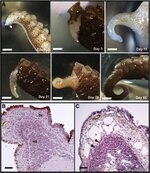Level_Head pointed out this article in The Journal of Experimental Zoology Volume 31 (1920)- William Keith Brooks, Wistar Institute of Anatomy and Biology, American Society of Zoologists, article by Mathilde M. Lange that discusses his observations and opinions as to what happens when an octopus arm is amputated. I found this a good paper to read on what to expect after an animal looses (or has lost before arrival) a part of an arm. She references a book by Adolf Naef that was submitted for publication at the writing of this document and a pdf copy can be found here.
Items of note (there is a good, point summary at the end of the paper):
-The arm does not bleed after amputation but DOES bleed some 5 - 6 hours later and creates a blood clot coverage for the raw end
-The suckers nearest the cut end change alignment and remain misaligned for a period of time. The first signs of regeneration occur when the suckers return to their normal position
-Healing time seems to vary with age, location of the cut (the closer to the tip the faster the healing), and season (possibly temperature rather than season? Observation was faster in spring and slower in fall but no temperature differences were noted).
-Squid may completely replace an arm rather than regenerate one from the severed end. He was not able to fully observe regeneration in squid because the experimental animals did not live long enough to observe the process.
Other Related Threads:
A Bleedin Octopus!
Removal of GPO limbs for food
Extra Arms
Octopus Have Legs
Arm Branching
Items of note (there is a good, point summary at the end of the paper):
-The arm does not bleed after amputation but DOES bleed some 5 - 6 hours later and creates a blood clot coverage for the raw end
-The suckers nearest the cut end change alignment and remain misaligned for a period of time. The first signs of regeneration occur when the suckers return to their normal position
-Healing time seems to vary with age, location of the cut (the closer to the tip the faster the healing), and season (possibly temperature rather than season? Observation was faster in spring and slower in fall but no temperature differences were noted).
-Squid may completely replace an arm rather than regenerate one from the severed end. He was not able to fully observe regeneration in squid because the experimental animals did not live long enough to observe the process.
Other Related Threads:
A Bleedin Octopus!
Removal of GPO limbs for food
Extra Arms
Octopus Have Legs
Arm Branching


